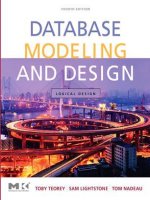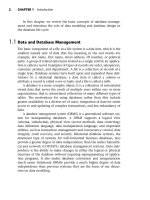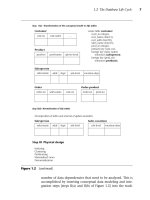Database Modeling & Design Fourth Edition- P19 pdf
Bạn đang xem bản rút gọn của tài liệu. Xem và tải ngay bản đầy đủ của tài liệu tại đây (160.37 KB, 5 trang )
4.5 Entity Clustering for ER Models 77
• Dominance grouping
• Abstraction grouping
• Constraint grouping
• Relationship grouping
These grouping operations can be applied recursively or used in a
variety of combinations to produce higher-level entity clusters, that is,
clusters at any level of abstraction. An entity or entity cluster may be an
Figure 4.9 Grouping operations
(a) Dominance grouping (b) Abstraction grouping
(c) Constraint grouping
(d) Relationship grouping
Teorey.book Page 77 Saturday, July 16, 2005 12:57 PM
78 CHAPTER 4 Requirements Analysis and Conceptual Data Modeling
object that is subject to combinations with other objects to form the
next higher level. That is, entity clusters have the properties of entities
and can have relationships with any other objects at any equal or lower
level. The original relationships among entities are preserved after all
grouping operations, as illustrated in Figure 4.8.
Dominant objects or entities normally become obvious from the ER
diagram or the relationship definitions. Each dominant object is
grouped with all its related nondominant objects to form a cluster. Weak
entities can be attached to an entity to make a cluster. Multilevel data
objects using abstractions such as generalization and aggregation can be
grouped into an entity cluster. The supertype or aggregate entity name is
used as the entity cluster name. Constraint-related objects that extend
the ER model to incorporate integrity constraints, such as the exclusive-
OR can be grouped into an entity cluster. Additionally, ternary or higher
degree relationships potentially can be grouped into an entity cluster.
The cluster represents the relationship as a whole.
4.5.3 Clustering Technique
The grouping operations and their order of precedence determine the
individual activities needed for clustering. We can now learn how to
build a root entity cluster from the elementary entities and relationships
defined in the ER modeling process. This technique assumes that a top-
down analysis has been performed as part of the database requirement
analysis and that the analysis has been documented so that the major
functional areas and subareas are identified. Functional areas are often
defined by an enterprise’s important organizational units, business activ-
ities, or, possibly, by dominant applications for processing information.
As an example, recall Figure 4.3 (reconstructed in Figure 4.10), which
can be thought of as having three major functional areas: company
organization (division, department), project management (project, skill,
location, employee), and employee data (employee, manager, secretary,
engineer, technician, prof-assoc, and desktop). Note that the functional
areas are allowed to overlap. Figure 4.10 uses an ER diagram resulting
from the database requirement analysis to show how clustering involves
a series of bottom-up steps using the basic grouping operations. The fol-
lowing list explains these steps.
1. Define points of grouping within functional areas. Locate the domi-
nant entities in a functional area through natural relationships,
local n-ary relationships, integrity constraints, abstractions, or
Teorey.book Page 78 Saturday, July 16, 2005 12:57 PM
4.5 Entity Clustering for ER Models 79
Figure 4.10 ER diagram: clustering technique
1
1
1
N
belongs-to
N
N
is-allocated
1
1
has-
allocated
1
1
is-
managed-by
contains
is-
headed-byhas
d
1
1
N
1
1
11N
Employee
N
1
Project
TechnicianEngineerSecretaryManager
Prof-assocWorkstationDesktop
skill-used
assigned-to
Department
Division
N
N
Location
Skill
is-allocated
1
1
is-
married-to
manages
+
N
N
Employee
data
functional
area
Project
management
functional
area
Company
organization
functional
area
Teorey.book Page 79 Saturday, July 16, 2005 12:57 PM
80 CHAPTER 4 Requirements Analysis and Conceptual Data Modeling
just the central focus of many simple relationships. If such points
of grouping do not exist within an area, consider a functional
grouping of a whole area.
2. Form entity clusters. Use the basic grouping operations on elemen-
tary entities and their relationships to form higher-level objects,
or entity clusters. Because entities may belong to several potential
clusters, we need to have a set of priorities for forming entity clus-
ters. The following set of rules, listed in priority order, defines the
set that is most likely to preserve the clarity of the conceptual
model:
a. Entities to be grouped into an entity cluster should exist
within the same functional area; that is, the entire entity clus-
ter should occur within the boundary of a functional area. For
example, in Figure 4.10, the relationship between Department
and Employee should not be clustered unless Employee is
included in the company organization functional area with
Department and Division. In another example, the relation-
ship between the supertype Employee and its subtypes could
be clustered within the employee data functional area.
b. If a conflict in choice between two or more potential entity
clusters cannot be resolved (e.g., between two constraint
groupings at the same level of precedence), leave these entity
clusters ungrouped within their functional area. If that func-
tional area remains cluttered with unresolved choices, define
functional subareas in which to group unresolved entities,
entity clusters, and their relationships.
3. Form higher-level entity clusters. Apply the grouping operations
recursively to any combination of elementary entities and entity
clusters to form new levels of entity clusters (higher-level objects).
Resolve conflicts using the same set of priority rules given in step
2. Continue the grouping operations until all the entity represen-
tations fit on a single page without undue complexity. The root
entity cluster is then defined.
4. Validate the cluster diagram. Check for consistency of the interfaces
(relationships) between objects at each level of the diagram. Ver-
ify the meaning of each level with the end users.
The result of one round of clustering is shown in Figure 4.11, where
each of the clusters is shown at level 2.
Teorey.book Page 80 Saturday, July 16, 2005 12:57 PM
4.6 Summary 81
4.6 Summary
Conceptual data modeling, using either the ER or UML approach, is par-
ticularly useful in the early steps of the database life cycle, which involve
requirements analysis and logical design. These two steps are often done
simultaneously, particularly when requirements are determined from
interviews with end users and modeled in terms of data-to-data relation-
Figure 4.11 Clustering results
Division/
Department
Cluster
is-
managed-by
is-
headed-by
has
d
N
N
111
11N
Employee
Department Division
2.1
Manager
cluster
2.3
Secretary
cluster
2.4
Engineer
cluster
2.5
Technician
skill-used
assigned-to
Project
management
cluster
2.2
N
Project
Project
P
1
N
Skill
Location
is-
married-to
manages
1
1
1
N
+
Teorey.book Page 81 Saturday, July 16, 2005 12:57 PM









